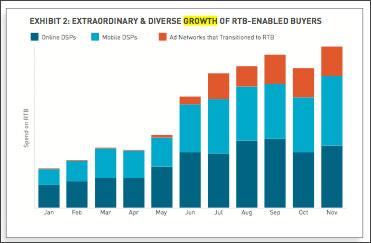Commentary
The Catalyst(s) Behind Mobile Private Exchanges
- by Tyler Loechner , Staff Writer @mp_tyler, December 16, 2013
Private exchanges have very publicly become a strategy of note this year for programmatic traders, but when did it all start, and why? By the looks of some new data from Nexage, the first big jump in revenue generated from mobile private exchanges occurred in June:

But what kick-started that path of growth? Victor Milligan, chief marketing officer of Nexage, suggested that publishers may not be solely responsible — or even the primary factor — for the adoption of private exchanges. He said, “The fundamental catalyst for private exchange success is the diversity and strength of buyers.”
When you look at a second chart, which details who has become an RTB-enabled buyer and when, it supports Milligan's opinion. The number of companies able to buy in a real-time bidding (RTB) environment also saw a big jump in June:

Milligan said publishers could always find value in a private exchange because it gave them better controls and CPM upside, but the money from the buy-side wasn’t always there. He continued, “The difference now is that publishers are able to get both CPM and meaningful revenue value because of the strong spending trends of buyers.”
As the RTB market is a prime case study of supply and demand, it makes sense that the catalyst behind the rise of mobile private exchanges is really a combination of two things — one each from the buy- and sell-side.
What the sell-side contributed to the spark, Milligan theorized, was the addition of “more premium inventory to bid on.”
On the buy-side,
it was simply having more money to spend, which in turn led to “more competition per auction and better liquidity overall,” Milligan said.
Nexage wrote in the report that it
"expect[s] private exchange share of spend to grow substantially,” which is saying something considering revenue generated from private exchanges grew 569% in the third quarter alone.



